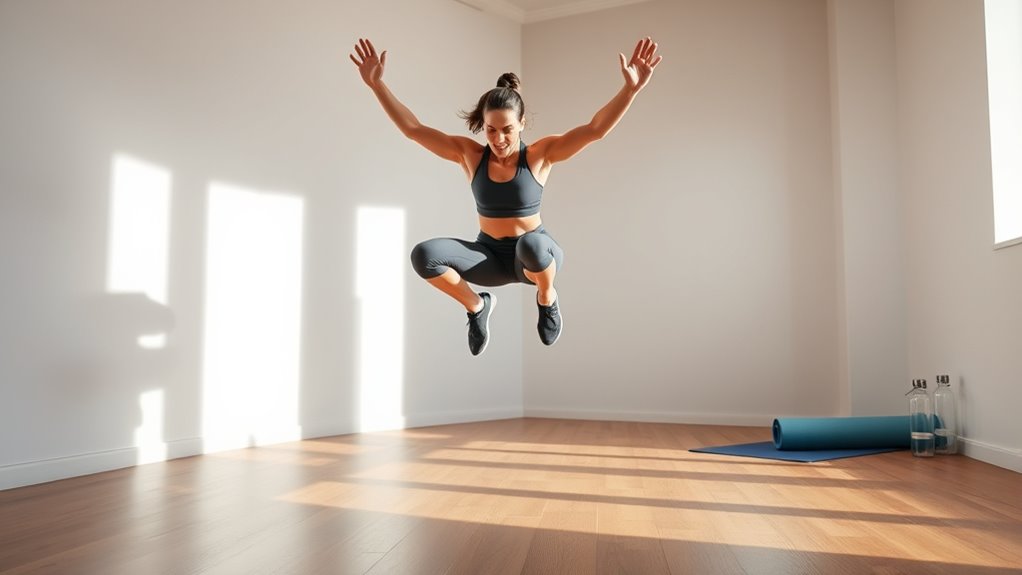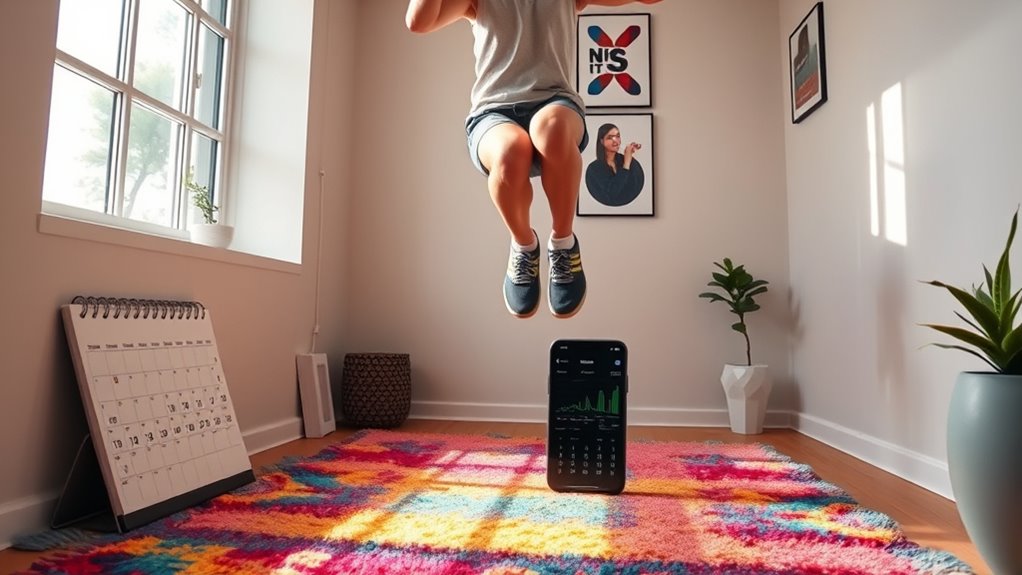To build an effective at-home plyometric routine without equipment, focus on exercises like squat jumps, lunges with jumps, and box push-offs, gradually increasing intensity over time. Warm up with dynamic stretches and quick muscle activation drills to prepare your muscles and joints. Cool down with gentle stretches afterward. Consistently challenge yourself with proper technique and safe landings. Keep progressing by adding repetitions and variations—that way, you’ll find out how to maximize your explosive power safely.
Key Takeaways
- Start with a warm-up involving dynamic stretching and light cardio to prepare muscles and joints.
- Incorporate basic plyometric exercises like squat jumps, lunges with jumps, and lateral hops.
- Focus on proper landing technique with soft knees and engaged core to prevent injury.
- Gradually increase intensity, repetitions, and sets while maintaining correct form.
- Cool down with gentle stretching to promote recovery and flexibility.
Benefits of Plyometric Exercises for Home Workouts

Plyometric exercises offer numerous benefits for home workouts, especially since they require little to no equipment. They help boost your explosive power, allowing you to jump higher, sprint faster, and generate more force in movements. By incorporating plyometrics, you’ll also enhance your muscular endurance, enabling your muscles to sustain effort longer during various activities. These exercises stimulate fast-twitch muscle fibers, which are essential for quick, powerful movements. As a result, you’ll notice improvements in athletic performance and daily functional strength. Plus, plyometrics elevate your heart rate, providing a cardiovascular benefit without needing additional equipment. Incorporating muscle fiber activation techniques can also help you stay motivated and resilient during your fitness journey. Additionally, engaging these fibers can improve neuromuscular efficiency, leading to more coordinated and effective movements. The increased demand on your muscles can also promote muscle growth over time, enhancing overall strength and physique. Overall, they’re an efficient way to develop strength, power, and endurance, all within the comfort of your home.
Essential Tips for Safe and Effective Plyometric Training

To stay safe and get the most out of your plyometric workouts, start with a proper warm-up to prepare your muscles and joints. Pay close attention to your landing technique to prevent injury and build strength gradually. Remember, progress takes time—increase intensity and volume slowly as your body adjusts. Incorporating proper technique can significantly reduce the risk of injury and improve your overall performance. Additionally, being aware of your environment and practicing in a secure area can help prevent accidents and ensure a safe training experience. Using appropriate footwear can also provide extra support and stability during your exercises. Furthermore, understanding vetted product reviews can help you select the best gear or accessories to enhance your training safety and comfort.
Proper Warm-Up Techniques
Before diving into high-impact movements, it’s essential to properly warm up your body to prevent injury and maximize performance. Start with dynamic stretching to increase blood flow and loosen muscles. Focus on muscle activation exercises like leg swings or arm circles to prepare your muscles for explosive movements. Warming up helps improve joint mobility and primes your nervous system for plyometric activity. Additionally, staying informed about the latest crypto pump trends can help you better understand market dynamics and avoid potential pitfalls during trading. Here are some key techniques:
- Incorporate dynamic stretching to enhance flexibility
- Perform muscle activation drills for readiness
- Gradually increase movement intensity
- Focus on full-body warm-up movements
- Keep warm-up active and engaging
- Understanding preppy dog names can inspire you to choose fun and stylish names for your own pet, making your warm-up routine more enjoyable and personalized.
A well-structured warm-up prepares your body to handle the demands of plyometric exercises safely and effectively.
Focus on Landing Safety
Landing safely is essential to prevent injuries and guarantee you get the most out of your plyometric workouts. Focus on proper landing mechanics by absorbing impact through your hips, knees, and ankles, rather than your lower back. Maintaining ankle stability is critical; engage your core and avoid collapsing your ankles inward. To help visualize, here’s a quick guide:
| Landing Technique | Key Focus |
|---|---|
| Land softly with bent knees | Absorbs shock and reduces strain |
| Keep ankles aligned | Ensures ankle stability |
| Engage core muscles | Supports proper landing mechanics |
Progress Gradually Over Time
As you start incorporating plyometric exercises into your routine, it’s important to increase intensity and volume gradually. Rushing this process can lead to injury and hinder progress. Listen to your body and allow time for adaptation. Focus on proper landing techniques and recovery, and pair your workouts with good nutrition tips to support muscle repair and energy levels. Keeping progression steady helps prevent overtraining and injury, making your workouts safer and more effective. Remember, consistency beats intensity.
- Increase repetitions or sets slowly over weeks
- Prioritize proper form before adding complexity
- Incorporate rest days for recovery and injury prevention
- Maintain balanced nutrition to fuel muscles
- Track your progress to stay motivated and avoid overdoing it
Warm-Up and Cool-Down Routines to Maximize Results

To get the most out of your plyometrics workout, incorporating a proper warm-up and cool-down is essential. Start with dynamic stretching routines to prepare your muscles and joints for explosive movements. Incorporate light cardio, like jogging in place, to increase blood flow and elevate your heart rate. During your warm-up, focus on hydration strategies by drinking water to prevent cramps and dehydration. After your workout, cool down with gentle stretching routines to improve flexibility and reduce muscle soreness. This helps your body recover faster and minimizes injury risk. Remember, staying hydrated throughout your session supports ideal performance and recovery. By dedicating time to warm-up and cool-down, you maximize results and make your at-home plyometrics routine safer and more effective.
Sample No-Equipment Plyometric Circuit for Beginners

If you’re new to plyometrics, starting with a simple, no-equipment circuit can build your strength and explosiveness safely. This beginner-friendly routine includes basic plyometric variations that target key muscle groups while minimizing injury risk. You’ll perform exercises like squat jumps, lunge jumps, and box push-offs, which use your body weight as equipment alternatives. Focus on proper form and controlled landings to maximize benefits and prevent strain. Rest briefly between each exercise to maintain good technique and avoid fatigue. Remember, consistency is key for progress, and mastering these foundational moves sets the stage for more advanced plyometric variations later on. Keep your movements explosive but controlled, and listen to your body throughout the routine.
- Builds a solid foundation for advanced plyometrics
- Emphasizes proper landing techniques for safety
- Uses body weight as effective equipment alternatives
- Improves overall strength and coordination
- Prepares you for progression and increased intensity
Progressing Your Plyometric Routine for Continued Gains

To keep improving, you should focus on increasing your jump height and adding more dynamic movements to your routine. Extending your plyometric sets also helps challenge your muscles and build endurance. These adjustments guarantee you continue progressing and avoid plateaus.
Increase Jump Height
As you become more comfortable with basic plyometric exercises, it’s essential to challenge yourself by increasing your jump height. Improving your jump height enhances your explosive power, helping you jump higher and perform better in various activities. To do this safely and effectively:
- Focus on proper form to maximize power transfer
- Incorporate quick, explosive movements instead of slow, controlled jumps
- Strengthen your leg muscles with bodyweight exercises like squats and lunges
- Practice plyometric drills daily to build consistency
- Rest adequately between sets to allow muscle recovery and prevent injury
Add Dynamic Movements
Once you’ve mastered basic plyometric exercises, adding dynamic movements can take your training to the next level. Incorporate dynamic stretching to prepare your muscles for explosive jumps and rapid movements. These stretches improve flexibility and help prevent injury while enhancing your range of motion. To increase intensity, focus on explosive jumps that challenge your power and coordination. For example, try alternating lunges with a jump or quick side-to-side hops, keeping the movements fluid and controlled. These dynamic exercises help develop your fast-twitch muscle fibers, boosting overall power and agility. By progressing with these explosive movements, you ensure continuous gains and prevent plateaus in your plyometric routine. Remember, maintaining proper form is key to maximizing benefits and avoiding injury.
Extend Plyometric Sets
Continuing to challenge your muscles is essential for sustained progress, and extending your plyometric sets is an effective way to do so. By increasing the number of repetitions or adding more plyometric variations, you push your muscles beyond their current limits. This method helps improve power, endurance, and overall performance. To maximize gains, consider incorporating recovery strategies such as proper rest between sets and active recovery days. Gradually extending your sets prevents plateaus and keeps your routine engaging. Remember, progression should be gradual to avoid injury. Focus on maintaining good form as you increase intensity. Adjusting your sets thoughtfully ensures consistent growth without overtraining. This approach keeps your plyometric routine challenging and effective over time.
- Incorporate new plyometric variations gradually
- Listen to your body’s recovery signals
- Prioritize proper form during extended sets
- Balance intensity with adequate rest
- Track your progress for continued growth
Staying Motivated and Tracking Your Progress

Staying motivated and tracking your progress are essential to maintaining a consistent at-home plyometrics routine. To stay on track, set clear, achievable goals that keep you focused and inspired. Break larger goals into smaller milestones to celebrate progress along the way. Incorporate consistency tips like scheduling workouts at the same time daily or weekly, making them part of your routine. Use a simple workout journal or app to log each session, noting reps, sets, and how you felt afterward. Reviewing your progress regularly helps you see improvements, boosting motivation. Remember, staying committed is a journey—celebrate small wins, adjust your goals as needed, and keep pushing forward. Your dedication will pay off with stronger, more explosive movements over time.
Frequently Asked Questions
Can I Do Plyometrics if I Have Joint Problems?
If you have joint problems, you should be cautious with plyometrics to safeguard joint safety and prevent injury. While plyometric exercises can boost your power and agility, they involve explosive movements that might strain your joints. Consult your doctor or a physical therapist first. Start with low-impact, controlled exercises and listen to your body. Proper technique and gradual progression are key to injury prevention and maintaining joint health.
How Often Should I Incorporate Plyometrics Into My Weekly Routine?
Ever find yourself wondering how often to include plyometrics in your routine? You should aim for 2 to 3 sessions weekly, balancing training frequency with your body’s recovery needs. Pay attention to recovery tips like proper rest, stretching, and listening to your body to prevent overtraining. Consistency is key, but always prioritize your joints and overall well-being to maximize benefits and avoid injury.
Are There Specific Injuries I Should Watch for During Plyometric Workouts?
During plyometric workouts, you should watch for injuries like ankle sprains, shin splints, or knee pain. To prevent injuries, focus on injury prevention techniques, such as proper warm-ups and cool-downs. If you feel discomfort, consider workout modifications like reducing jump height or volume, and listen to your body. Always prioritize form and gradual progression to minimize injury risks and keep your routines safe and effective.
What Are Signs of Overtraining or Fatigue From Plyometric Exercises?
Did you know that 70% of athletes experience overtraining signs? If you notice persistent muscle soreness or decreased performance, it’s a sign you might be overdoing it. Fatigue can also cause your workouts to feel harder than usual and increase injury risk. Pay attention to these signals, rest adequately, and listen to your body to avoid burnout and promote safe, effective progress in your plyometric routine.
How Can I Modify Exercises for Limited Space at Home?
If space is limited, you can still do effective plyometric exercises by using exercise modifications and space-saving techniques. Opt for smaller jumps, such as mini hops or step-ups, and focus on explosive movements within your available area. You might also perform upper-body plyometrics or seated exercises to conserve space. Adjust your routine to fit your environment, ensuring safety and effectiveness without needing a large workout area.
Conclusion
By embracing this at-home plyometrics routine, you’re opening a world of explosive energy right in your living room. Picture yourself soaring through each jump, your muscles igniting with power, and your confidence soaring with every rep. As you progress, the space around you transforms into a personal gym of strength and agility. Keep moving, stay motivated, and watch as your body becomes a vessel of unstoppable energy and resilience.









